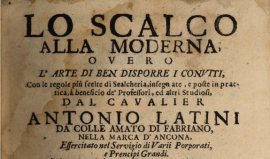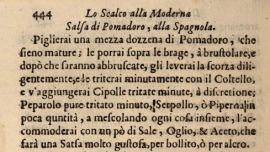Another blog post from Talia, the Master of Many Blogs. Today she’s working on a subject which began with a post on her latest food blog, I Eat Alone. Her previous guest posts can be found here and here.
 It began with trying to figure out how to make my own tomato sauce, and turned into one of my historical research adventures. After noticing a citation that the first recipe for tomato sauce was included in a 17th century Italian cookbook by Antonio Latini, I had to track it down. I finally located the correct passage, in translation:
It began with trying to figure out how to make my own tomato sauce, and turned into one of my historical research adventures. After noticing a citation that the first recipe for tomato sauce was included in a 17th century Italian cookbook by Antonio Latini, I had to track it down. I finally located the correct passage, in translation:
“Salsa di pomodoro alla spagnola (tomato sauce, Spanish style). Take half a  dozen ripe tomatoes and roast them in embers, and when they are charred, carefully remove the skin, and mince them finely with a knife. Add as many onions, finely minced, as desired; chilies [peparolo, in Neapolitan dialect], also finely minced; and a small amount of thyme. After mixing everything together, add a little salt, oil, and vinegar as needed. It is a very tasty sauce, for boiled dishes or anything else.”
dozen ripe tomatoes and roast them in embers, and when they are charred, carefully remove the skin, and mince them finely with a knife. Add as many onions, finely minced, as desired; chilies [peparolo, in Neapolitan dialect], also finely minced; and a small amount of thyme. After mixing everything together, add a little salt, oil, and vinegar as needed. It is a very tasty sauce, for boiled dishes or anything else.”
 The full post at my blog is here. I observed pretty quickly that this sounded more like what we’d now designate as a salsa rather than a sauce (even though ‘salsa’ technically just means sauce, including in this recipe’s name — “Salsa di pomodoro.”) Only the tomatoes are specified to be cooked, the rest of the ingredients seem to go in raw, which is definitely going to produce something pretty chunky in texture and not at all like we’d expect of modern tomato sauces.
The full post at my blog is here. I observed pretty quickly that this sounded more like what we’d now designate as a salsa rather than a sauce (even though ‘salsa’ technically just means sauce, including in this recipe’s name — “Salsa di pomodoro.”) Only the tomatoes are specified to be cooked, the rest of the ingredients seem to go in raw, which is definitely going to produce something pretty chunky in texture and not at all like we’d expect of modern tomato sauces.
While at the grocery store, a couple weeks after the discovery, I found tomatoes and onions on the discount rack, and decided it was a sign to give the salsa/sauce a try.

Now, as mentioned in previous guest posts here, I’m American but hang around in the UK a lot. Tomatoes around here (Scotland) are usually smaller than we typically see in the states, and are conveniently sold in packs of 6; this was perfect for the recipe, supposedly, but since no one but me was going to be eating this stuff and really there are no other quantities given for anything in the original recipe, I didn’t particularly see why I should have to use all 6 of them for it. So I used three — including the one that was quickly going south and was probably the reason for the package’s markdown. I’m sure tomatoes weren’t always at their freshest in Latini’s day, either.
It’s of note, for anyone who isn’t brushed up on their food history, that tomatoes are a New World food, and were brought to Europe by the Spaniards sometime in the 16th or 17th century, where for quite a while they were the only people who would eat them because everyone else thought they were poisonous. No wonder this is considered a Spanish sauce! Given its similarity to modern pico de gallo salsa which is still used in Mexico, I speculate it might even be modeled after something the Indians were doing with the fruit.
Anyway… to make the sauce, I began with 3 tomatoes. I did not have any “embers” available for roasting them, so instead I pre-heated the oven as hot as it would go, then turned on the broiler, and put the tomatoes in the oven in a bread pan. I let them cook about 6 minutes, till they were starting to turn black. They were hot, but still had a touch of body to them — not total mush. Peeling them was easy, chopping them was a bit wetter than I’d have liked but was done in short order. I’d estimate I got 3/4 cup diced cooked tomato from it, to which I added…
1/2 onion diced (about 1/3 c)
1 medium jalapeno, diced (about 1 tbs)
1/4 tsp dried thyme
1/8 tsp salt
dash vinegar (a wine vinegar would be most appropriate, but I didn’t have any and figured the taste wasn’t going to be much changed if I used white vinegar instead)
1 tsp olive oil
Mixed it all together, tasting frequently, and…
…it’s salsa.
I mean really, it’s just salsa. It tastes exactly like every restaurant salsa in New Mexico, and I felt weird for not having any tortilla chips to dip into it.
Still, I needed to try it on some food, so I used it to top some eggs. And it tastes like eggs with salsa on them. I think I will be making nachos and tacos from the leftovers.
So here’s a question: did they ever use this sauce on pasta? I kind of doubt it, because firstly, older pasta recipes are usually cheese-and-spice dishes rather than meat-and-vegetable like now. Also, I don’t think it would have stuck to noodles very well. This is certainly more of a thing to plop over chunks of meat, rather than to try to coat a piece of spaghetti with.
Antonio Latini’s cookbook The Modern Steward was published to showcase recipes he’d learned in Spain, and to describe the new style of upper-class food which was less heavily spiced than Medieval and Renaissance menus (which were a bit more like eating Indian curries in that almost all the food was very heavily seasoned with spices.) Mild dishes like cream sauces began to emerge around this same time — a real change from old fashioned spice-and-vinegar mixes. Yet when you take that into account, the inclusion of the newly discovered chile pepper also doesn’t seem so shocking, since strong tastes were already established in the cuisine of the day.
You can read The Modern Steward online in the original Italian from Google Books.

Re tomatoes considered poisonous – They are botanically close to potatoes which produce a small tomato-like fruit that is very toxic. Whether potatoes were a familiar food crop before tomatoes came on the scene is for the historians to tell us. Over to you!
I’ve just discovered that a cookbook I’ve had for many years is quite the collector’s item. It’s part of the ‘Italy in Bocca’ series of 20 regional books published in 1979. My post about it: http://ambradambra.wordpress.com/2013/07/16/lurking-in-the-cupboard-6-italy-in-bocca-cookbook/